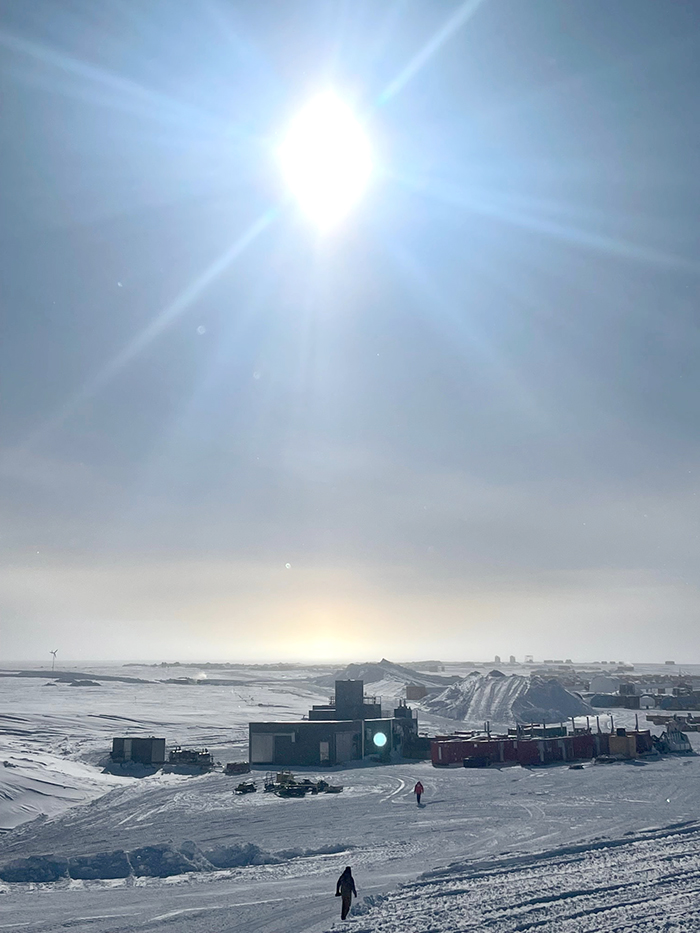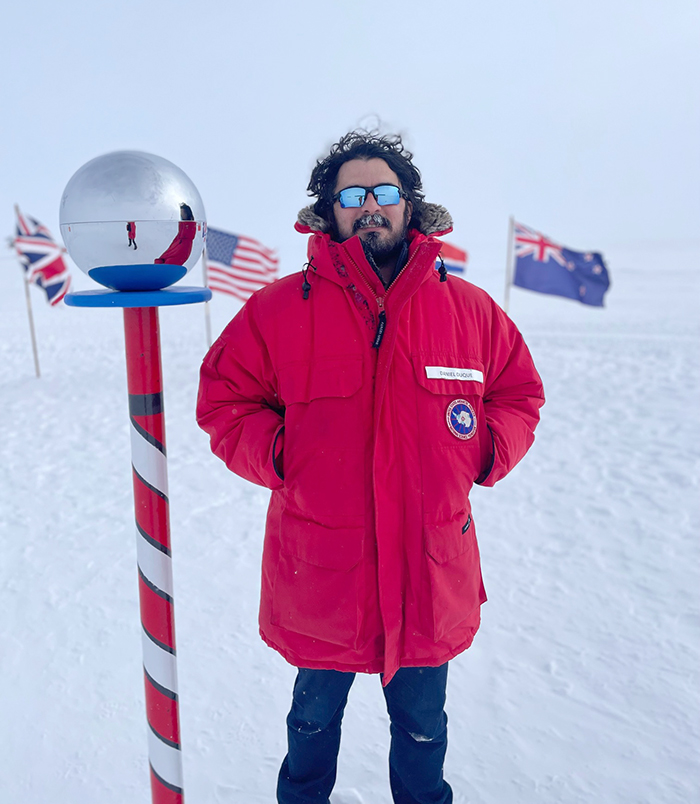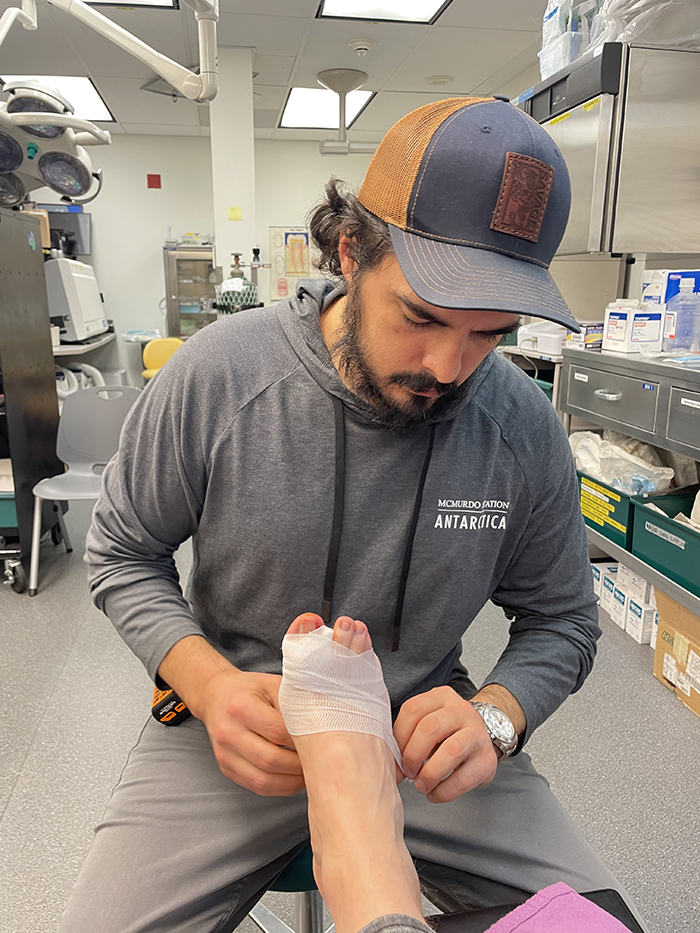- Welcome
- Campus Maps
- History
- Mission Statement
- Accreditation
- Administration
- Employment
- Human Resources Employment Process FAQ
- Position Vacancies
- Salary Schedule (PDF)
- Employee Benefits
- Paid Holidays
- Employee Handbook (PDF)
- BENCOR Special Pay Plan (PDF)
- Social Security Collection and Usage
- Affordable Care Act Notice (PDF)
- Social Security Disclosure Summary (PDF)
- Tobacco-Free College
- Drug-Free Workplace & Campuses
- Technology Usage Acknowledgement (PDF)
- Employee Safety Manual (PDF)
- SFSC’s Annual Security and Fire Safety Report (PDF)
- Calendars
- News
- Social Media
- Honoring Our Retirees
- Celebrating Our Trustees
AVON PARK, Fla. – Feb. 1, 2024 – Daniel Duque, a South Florida State College (SFSC) alumnus, works 90 degrees south of everywhere on earth. His office is 150 feet from the geographical South Pole at the Amundsen-Scott South Pole Station. According to Duque, “I can walk around the world in a few steps.”
Duque earned his Associate in Science in Nursing from SFSC in 2016. While working on his nursing degree, he wondered how far his nursing career could take him. He searched the internet for opportunities to travel as a nurse. Those searches brought him to the University of Texas Medical Branch (UTMB), which is considered a gateway to working “on the ice.”
“Everyone in Antarctica – ‘the ice’ – works as a contractor or National Science Foundation (NSF) grantee,” Duque said. “The NSF is the parent organization that is in charge of all science projects. Support staff, such as cooks, medical, logistics, facility maintenance, and so forth are hired under subcontractors to the NSF. All companies make bids to the NSF to get the contract. If you want to work in medical in Antarctica, the UTMB is your only option. The UTMB has an Aerospace Medicine Residency program for their medical residents and Antarctica is often used as an analog to conditions found in space. So, it made sense for UTMB to have the contract.”
Duque, who came to the United States from Havana, Cuba when he was 7 years old, was raised in Thonotosassa, Fla. He was on active duty with the U.S. Army from 2008 to 2013. He said that he joined the Army because his family had few financial resources. When he joined, he decided to take the most difficult job the Army had to offer – Army Special Forces, the Green Berets. “It gave me the opportunity and resources to invest in myself,” he said. “And I was able to pay my way through college.”
Duque’s interest in becoming a nurse began while serving in the Army in Afghanistan. “I was introduced to a mobile trauma unit,” he said. “We had C-130 planes retrofitted with a surgical center. The mobile trauma unit also brings basic equipment that saves lives on the field of battle. I had the opportunity to speak with a surgeon, a nurse anesthetist, a physician’s assistant, or a nurse. That experience made a profound impact on my life. In war, almost anyone is capable of taking a human life. But here was a small group of men and women who could save a human life.”
After he was honorably discharged from the Army, Duque and his wife moved to Lakeland, Fla., but he chose to attend SFSC for nursing school. “SFSC’s Nursing program had a great reputation,” he said. “Its passing score for the National Council Licensure Examination (NCLEX) was really high. I can’t recall how much my Associate Degree in Nursing (ADN) cost me — something like $9,800. But it was one of the best returns on investment of my life.”
Duque joined the Florida National Guard in 2013. Shortly after earning his Nursing degree and becoming a registered nurse, he was deployed to the Democratic Republic of Congo for nine months. “While my main job wasn’t nursing, I was able to help people by using the skills I gained during my training,” he said. “During my time off, I helped in a clinic.”
Upon returning from Africa, Duque started working toward his Bachelor of Science in Nursing (BSN) at the University of South Florida (USF) and graduated in 2018. He continued his education, was awarded his Master of Science in Nursing (MSN) from USF in 2020, and became a family nurse practitioner.
After completing his master’s degree, Duque applied to the UTMB, interviewed with the director, and was offered a job. However, the COVID-19 pandemic put his aspirations and travel around the world on hold. In 2023, he interviewed again and was offered a position in the South Pole.
“What interested me about the job was the remote location,” Duque said. “The South Pole station is often compared to the International Space Station in that it is one of the most remote and austere environments on earth. NASA, often, performs experiments there which directly apply to astronauts and space travel.”
Duque and a single physician work in a clinic six days a week from 7:30 a.m. to 5:30 p.m. The clinic has three sections: an urgent care/emergency trauma bay, a dental suite, and in-patient care/long-term care. Over the winter months, 42 people will serve on the station. In the summer, the population swells to nearly 130 people.
“The physician and I are the sole medical providers for over 800 miles,” Duque said. “We care for men and women ranging from 21 to 70 years old. This includes dental procedures, taking X-rays, running our own labs, physical therapy, pharmacy, and so forth. But we have plenty of time to provide good evidence-based practice and build lasting relationships with our patients. We are able to gain the trust of our patients.”
The most common visits on the station are related to the climate. The high altitude and dry climate lead to acute mountain sickness, frost nip, dehydration, sleep deprivation, and other work-related injuries.
The environment at the South Pole is harsh. According to Duque, a relatively warm temperature at the South Pole is minus 30.7 C (minus 23 F) with a wind chill factor of minus 41.1 C (minus 42 F). Although the majority of Antarctica is at sea level, the Amundsen-Scott South Pole Station is at the top of a polar plateau, at an elevation of 9,306 feet above sea level.

A double sun at the South Pole
“Due to this environment, all personnel are given preventive care prior to arrival at the South Pole Station,” Duque said. “The first five days on the station are the most dangerous. During this time, we’re most likely to see acute mountain sickness (AMS), high altitude pulmonary edema (HAPE), or high-altitude cerebral edema (HACE). The last two are potentially deadly illnesses if not treated. Ironically, a person’s age, sex, body habitus, and even previous visits to high altitude locations tell us little of who is at risk.”
“The most rewarding part about the job is being able to provide care for world-class scientists and support staff and learn about airborne geophysics, glaciology, astronomy, neutrino and dark matter physics, weather, astrophysics, and drilling through ice to depths of 1,450 to 2,450 meters below the surface.”
Duque returns to the United States at the end of February 2024. He and his wife purchased a 5-acre farm in Lakeland, which they plan to develop into a homestead. He’s also applied to become an officer in the National Guard and return to running his signage company and medical practice.
“Being a nurse practitioner allows me to earn a good living, and it has great benefits,” Duque said. “I am able to provide for my family.
“Becoming a family nurse practitioner was always my goal,” he said. “It’s a great option for any nurse who is looking for work-life balance, the ability to travel, and to push themselves. You have a lot more autonomy to practice as a nurse practitioner.
“If someone is younger or, perhaps, has the freedom to travel (after kids have left the house), traveling as a nurse offers you a paid opportunity to see different parts of the world. Young people can build up their savings and start investing. More settled people can travel together and experience places they might not otherwise have been able to visit.”
For a virtual tour of the Amundsen-Scott South Pole Station, see https://www.youtube.com/watch?v=gQ3_gZ3ZS_4






